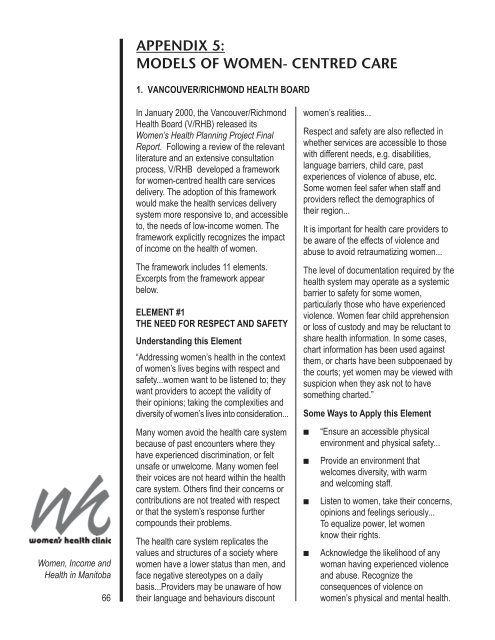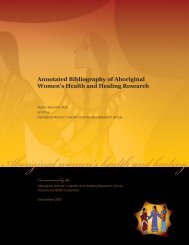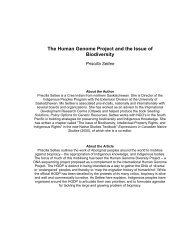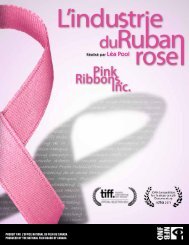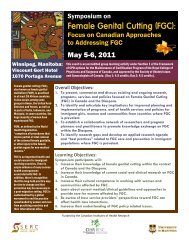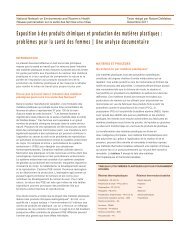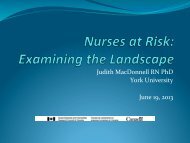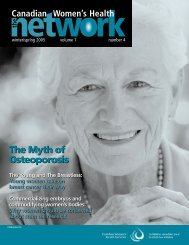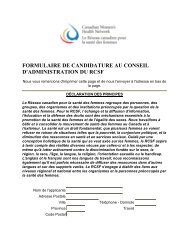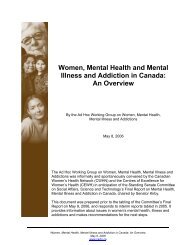here. - Canadian Women's Health Network
here. - Canadian Women's Health Network
here. - Canadian Women's Health Network
- No tags were found...
You also want an ePaper? Increase the reach of your titles
YUMPU automatically turns print PDFs into web optimized ePapers that Google loves.
APPENDIX 5:MODELS OF WOMEN- CENTRED CARE1. VANCOUVER/RICHMOND HEALTH BOARDWomen, Income and<strong>Health</strong> in Manitoba66In January 2000, the Vancouver/Richmond<strong>Health</strong> Board (V/RHB) released itsWomen’s <strong>Health</strong> Planning Project FinalReport. Following a review of the relevantliterature and an extensive consultationprocess, V/RHB developed a frameworkfor women-centred health care servicesdelivery. The adoption of this frameworkwould make the health services deliverysystem more responsive to, and accessibleto, the needs of low-income women. Theframework explicitly recognizes the impactof income on the health of women.The framework includes 11 elements.Excerpts from the framework appearbelow.ELEMENT #1THE NEED FOR RESPECT AND SAFETYUnderstanding this Element“Addressing women’s health in the contextof women’s lives begins with respect andsafety...women want to be listened to; theywant providers to accept the validity oftheir opinions; taking the complexities anddiversity of women’s lives into consideration...Many women avoid the health care systembecause of past encounters w<strong>here</strong> theyhave experienced discrimination, or feltunsafe or unwelcome. Many women feeltheir voices are not heard within the healthcare system. Others find their concerns orcontributions are not treated with respector that the system’s response furthercompounds their problems.The health care system replicates thevalues and structures of a society w<strong>here</strong>women have a lower status than men, andface negative stereotypes on a dailybasis...Providers may be unaware of howtheir language and behaviours discountwomen’s realities...Respect and safety are also reflected inwhether services are accessible to thosewith different needs, e.g. disabilities,language barriers, child care, pastexperiences of violence of abuse, etc.Some women feel safer when staff andproviders reflect the demographics oftheir region...It is important for health care providers tobe aware of the effects of violence andabuse to avoid retraumatizing women...The level of documentation required by thehealth system may operate as a systemicbarrier to safety for some women,particularly those who have experiencedviolence. Women fear child apprehensionor loss of custody and may be reluctant toshare health information. In some cases,chart information has been used againstthem, or charts have been subpoenaed bythe courts; yet women may be viewed withsuspicion when they ask not to havesomething charted.”Some Ways to Apply this Element■■■■“Ensure an accessible physicalenvironment and physical safety...Provide an environment thatwelcomes diversity, with warmand welcoming staff.Listen to women, take their concerns,opinions and feelings seriously...To equalize power, let womenknow their rights.Acknowledge the likelihood of anywoman having experienced violenceand abuse. Recognize theconsequences of violence onwomen’s physical and mental health.


